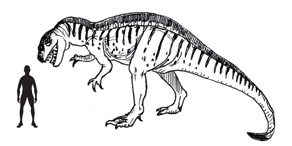Acrocanthosaurus – Allosaurid or Carcharodontosaurid
One of the most dangerous animals around in North America during the Early Cretaceous was the fierce, meat-eater Acrocanthosaurus. This dinosaur is only known from a few disarticulated fossils, although named in the 1950s, the best preserved skeleton of this dinosaur were found in the 1990s but even today remains of this bus-sized carnivore are extremely rare when compared to fossils of the geologically older meat-eater Allosaurus fragilis which lived in the Late Jurassic.
Acrocanthosaurus
One of the more recent fossil discoveries was found at the Antlers Formation of early Cretaceous strata in Oklahoma, the fossils found here represented approximately 50% of the animal’s entire body. Importantly, skull material was found and this helped give scientists an insight into what the head of this particular dinosaur looked like.
A Scale Drawing of Acrocanthosaurus

Picture credit: Everything Dinosaur
This dinosaur had many features typical of allosaurids, however, its classification remains unclear as some palaeontologists have claimed that the fossilised bones and teeth link this dinosaur more closely to a sub-group of the allosaurs – the carcharodontosaurids. Until more fossils are found, scientists are going to be remain unsure as to how this particular theropod was related to other meat-eating dinosaurs.
To see a model of Acrocanthosaurus and models of other carnivorous dinosaurs: Dinosaur and Prehistoric Animal Models.
Remarkable Acrocanthosaurus
The most remarkable thing about Acrocanthosaurus was the low fin, or hump that run down its neck and along its back. Large neural spines stick out of the vertebrae and in life these would have supported a fin or a hump on the animal. Some of these spines in areas like the dorsal and sacral vertebrae are over 50 cm tall. They have a blade-like or spatula appearance and scientists are not sure what function these neural processes would have served. One thing they can all agree on, with a skull measuring 135 cm long and with 68 sharp teeth in its jaws this dinosaur was an apex predator and one of the most feared animals in the Early Cretaceous of North America.
Just for good measure, fossil trackways unearthed in Texas may have been made by Acrocanthosaurus and these footprints indicate that these 12-metre-long giants may have hunted in packs. If these large, theropod dinosaurs were pack hunters then this suggests a social structure, or something akin to a flock mentality. It remains unclear as to how much social co-operation there may have been amongst species that make up the Order Dinosauria, but a hunting pack of Acrocanthosaurus would have been a very formidable proposition indeed.






Leave A Comment